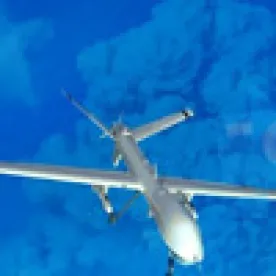The Federal Aviation Administration will allow CNN to test the use of drones in news gathering under a research agreement that will study how drones can be used safely and effectively by news organizations.
While the FAA has granted limited exemptions for commercial drone use in controlled settings, such as film sets, the agency has been less open to the use of drones in more fluid situations, such as breaking news events. The FAA has issued several warning letters to TV stations and journalism schools that have used drones to cover news stories.
The agreement announced on January 12, 2015, between the FAA, CNN, and the Georgia Tech Research Institute will come as a promising development for news organizations that have argued that certain types of news gathering — such as weather and traffic coverage — will be made safer and more cost-effective with drones. The FAA will use data collected from its agreement with CNN to develop a framework to safely integrate drones into news gathering.
Many important details of the agreement, including the agreement itself, were not released. It is unknown if the drone operators will be required to be licensed pilots and if the footage obtained will be used on the air or only for test purposes. (Exemptions the FAA provided to several film production companies last year required each drone operator to possess a private pilot certificate and a third-class medical certificate, and also required a visual observer for each flight, as well as a schedule of filming to be submitted three days in advance — requirements that would not be workable in breaking news situations.)
“Our aim is to get beyond hobby-grade equipment and to establish what options are available and workable to produce high quality video journalism using various types of UAVs and camera setups,” CNN Senior Vice President David Vigilante said in a statement. “Our hope is that these efforts contribute to the development of a vibrant ecosystem where operators of various types and sizes can safely operate in the US airspace.”
FAA Administrator Michael Huerta, who has been under pressure from Congress to more rapidly integrate drones into the national airspace, said: “Unmanned aircraft offer news organizations significant opportunities. We hope this agreement with CNN and the work we are doing with other news organizations and associations will help safely integrate unmanned newsgathering technology and operating procedures into the National Airspace System.”
Some news organizations have argued that they have a First Amendment right to deploy drones in news gathering. However, the National Transportation Safety Board, in ruling in November 2014 that the FAA has statutory authority to regulate small unmanned aircraft systems (UAS) under 55 pounds, stated that such constitutional issues were “outside the scope” of its review.
CNN is the first news organization to receive permission from the FAA to use drones in news gathering. Many others would be interested in drone use, however. News organizations have stated that reports on traffic, hurricanes, wildfires and crop yields, among other stories, could be presented more safely and cost-effectively with the use of drones.
The FAA was expected to release a notice of proposed rulemaking on the use of small UAS by the end of last year, but the agency has not yet taken that first step toward reaching a final set of regulations. Meanwhile, the FAA has received 214 applications for drone use exemptions and has granted 14 exemptions to date.



 />i
/>i
